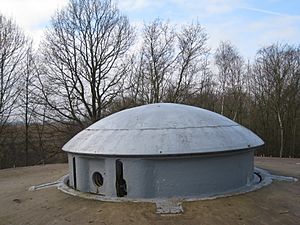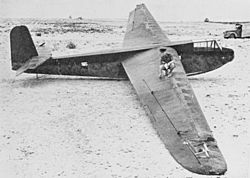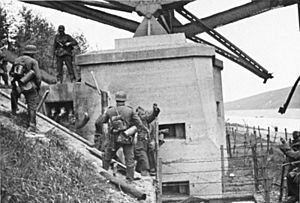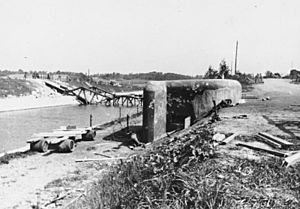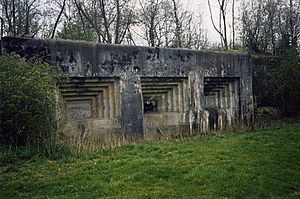Battle of Fort Eben-Emael facts for kids
Quick facts for kids Battle for Fort Eben Emael |
|||||||
|---|---|---|---|---|---|---|---|
| Part of the Battle of Belgium in the Second World War | |||||||
 Map of the area between Belgium and the Netherlands near Fort Eben-Emael |
|||||||
|
|||||||
| Belligerents | |||||||
| Commanders and leaders | |||||||
| Strength | |||||||
| 493 | 1,200+ (estimated) | ||||||
| Casualties and losses | |||||||
| 6 killed 20 wounded |
100 killed or wounded 1,000+ captured |
||||||
The Battle of Fort Eben-Emael was an important fight during World War II. It happened in May 1940 between Belgian and German forces. This battle was part of a larger German plan called Fall Gelb (meaning "Plan Yellow"). This plan was Germany's invasion of the Low Countries (like Belgium and the Netherlands) and France.
German paratroopers, known as Fallschirmjäger, had a special mission. They needed to attack and capture Fort Eben-Emael. This Belgian fortress was very important because its big guns could control several key bridges. These bridges crossed the Albert Canal and led into the heart of Belgium. The German army wanted to use these roads to advance quickly.
While some German airborne troops attacked the fort, others captured three bridges over the canal. They stopped the fort's defenders and its powerful guns. After taking the fort, the airborne troops protected the bridges. They held them until German ground forces arrived. This battle was a big win for Germany. The paratroopers landed on the fort using gliders. They used explosives and flamethrowers to break through the fort's defenses. They then entered the fortress, trapping most of the Belgian soldiers inside.
At the same time, other German troops landed near the bridges. They destroyed Belgian defenses and captured the bridges. The German airborne troops faced many dangers. But they held the bridges until more German soldiers arrived. These new troops helped attack the fort again, forcing the remaining Belgian soldiers to surrender. This victory allowed German forces to use the bridges. They could then move quickly into Belgium, helping their invasion.
Contents
Why This Battle Was Important
On May 10, 1940, Germany started its invasion plan, Fall Gelb. They attacked through the Netherlands, Luxembourg, and Belgium. The German high command wanted to go around the strong Maginot Line in France. Their goal was to move through southern Belgium into northern France. This would trap British and French forces and make France surrender.
To do this, German forces needed to get past Belgian and Dutch defenses. Some defenses were weak and only meant to slow down an attack. But others were very strong. These included large forts and many soldiers.
One main Belgian defense line was the K-W Line. It protected the city of Antwerp and the capital, Brussels. Before this line was a delaying defense along the Albert Canal. This canal line had small outposts with soldiers. But there was one area near the Dutch city of Maastricht where Belgium couldn't build forward defenses. This area was called the "Maastricht Appendix."
Here, the Belgian army placed an infantry division to guard three bridges over the canal. Each bridge had strong concrete bunkers with machine guns. Fort Eben-Emael provided artillery support. Its big guns could fire on two of the bridges.
The German leaders knew about Belgium's defense plan. They knew Belgian forces would try to hold the canal line briefly. Then they would retreat to join British and French forces on the K-W Line. Germany wanted to stop this plan. They decided to capture the three bridges in the "Maastricht Appendix." This would let their army break through defenses and advance quickly.
Getting Ready for Battle
Belgian Defenses
The Belgian 7th Infantry Division guarded the three bridges over the canal. They also supported the soldiers inside Fort Eben-Emael. Each bridge had four large concrete bunkers on the western side of the canal. Three bunkers had machine guns. The fourth had an anti-tank gun, placed near the road.
The Belgians had demolition charges placed in the bridges. These could be set off from the anti-tank bunkers. This would destroy the bridges if needed.
Fort Eben-Emael was built in the 1930s. It was made by digging into soft rock. Its walls and roofs were five feet thick with reinforced concrete. The fort had four hidden gun positions and 64 strongpoints. It had six 120mm artillery pieces that could shoot ten miles. It also had sixteen 75mm guns, twelve 60mm anti-tank guns, and many machine guns.
One side of the fort faced the canal. The other three sides faced land. These were protected by minefields, deep ditches, and a 20-foot high wall. There were also concrete bunkers with machine guns. Fifteen searchlights were on top of the fort. Many tunnels ran under the fort. They connected the gun turrets to the command center and ammunition storage. The fort also had its own hospital, living areas, and a power station.
Belgian plans did not expect a long fight at the fort. They thought they would get enough warning of an attack. This would allow them to pull back soldiers from the eastern side of the canal. Then they would destroy the bridges. The fort's soldiers would fight a delaying action. After that, they would retreat to the main defense lines.
German Preparations
The German airborne attack on Fort Eben-Emael and the bridges was a huge operation. It involved two large airborne divisions. The 7th Air Division was to capture bridges and airfields in the Netherlands. The 22nd Airlanding Division was to capture airfields near The Hague. Their goal was to take the Dutch government and royal family.
The force attacking the fort and bridges was called Sturmabteilung Koch. It was named after its leader, Hauptmann Walter Koch. This force was put together in November 1939. It was mostly made of paratroopers and engineers.
They decided to use gliders for the first landings. Adolf Hitler himself wanted gliders used. His pilot, Hanna Reitsch, told him gliders were almost silent. Belgian anti-aircraft defenses used sound to find planes, not radar. So, gliders could be towed close to the border and then released. This would create a surprise attack.
Fifty DFS 230 transport gliders were prepared. The soldiers trained intensely. They studied the fort and bridges in detail. They even built a replica of the area to practice on. They trained with flamethrowers and special explosives. These explosives were so secret they were only used on German fortifications. To keep the plan secret, gliders and equipment were hidden. Soldiers were not allowed to leave their barracks.
Hauptmann Koch divided his force into four groups:
- Group Granite: 85 men in 11 gliders. Their job was to attack and capture Fort Eben-Emael.
- Group Steel: 92 men in 9 gliders. They would capture the Veldwezelt bridge.
- Group Concrete: 96 men in 11 gliders. They would capture the Vroenhoven bridge.
- Group Iron: 90 men in 10 gliders. They would capture the Kanne bridge.
Time was very important for the attack. The Germans believed the silent gliders and no declaration of war would create surprise. But they thought this surprise would last only about 60 minutes. After that, the larger Belgian forces would fight back. So, the German plan was to destroy as many gun positions as possible within those 60 minutes. Especially important were the long-range guns that covered the bridges. They aimed to destroy these guns in just ten minutes.
The final plan was for gliders to land by the three bridges and on top of the fort. This would happen just before 5:30 AM on May 10. The groups at the bridges would quickly defeat the Belgian defenders. They would remove any explosives to save the bridges. Forty minutes later, more paratroopers would arrive by plane as reinforcements. At the same time, Group Granite would land on the fort. They would destroy the fort's guns and stop the Belgian soldiers inside. After securing their goals, the airborne troops would defend their positions until German ground forces arrived.
The Battle Begins
For safety, Sturmabteilung Koch was spread out in different places. They got orders to move to a meeting area on May 9. Soon after, they learned that Fall Gelb would start at 5:25 AM on May 10.
At 3:00 AM, the paratroopers gathered on a dark airfield. At 4:30 AM, 42 gliders carrying 493 airborne troops took off from two airfields in Cologne. They flew south towards their targets. The aircraft kept radio silence. Pilots had to follow signal fires pointing to Belgium. This silence meant commanders couldn't be told if a glider had problems. One glider's tow-rope snapped, forcing it to land in Germany. Another glider released its rope too early. Both gliders were carrying troops for Group Granite, making the group smaller. The commander, Oberleutnant Witzig, was in one of the gliders that landed early.
The remaining gliders were released 20 miles from their targets. They were at 7,000 feet high. This was high enough for them to land correctly on the bridges and the fort. As the planes released the gliders, Belgian anti-aircraft guns detected them and opened fire. This warned the Belgian defenders.
Fighting at the Bridges
All nine gliders for Group Steel landed near the Veldwezelt bridge at 5:20 AM. Barbed wire on their landing skids helped them stop quickly. One glider landed right in front of a Belgian bunker. This bunker started shooting at the Germans. A German soldier threw grenades at the bunker. Another placed explosives at the door and blew it up, clearing the way.
At the same time, the German commander, Altmann, led his troops along a ditch. Two men reached the canal bank. They climbed onto the bridge and cut the wires to the Belgian demolition charges. This stopped the Belgians from blowing up the bridge. The Belgian defenders fought hard until German reinforcements arrived. They were forced to retreat. However, two Belgian field guns 500 meters away kept firing. Altmann called for air support. Several Stuka dive-bombers attacked and destroyed the guns. Group Steel was supposed to be relieved by 2:30 PM, but Belgian resistance delayed this until 9:30 PM. Eight German soldiers died and 30 were wounded in this fight.
Ten of the eleven gliders for Group Concrete landed near the Vroenhoven bridge at 5:15 AM. The eleventh glider was hit by anti-aircraft fire and landed early in the Netherlands. The gliders faced heavy anti-aircraft fire as they landed. One glider crashed, badly wounding three soldiers. The others landed safely.
One glider landed very close to the bunker with the bridge detonators. This allowed the German troops to quickly attack it. They killed the soldiers inside and cut the wires to the explosives. This made sure the bridge could not be destroyed. The remaining Belgian defenders fought fiercely. They launched several counter-attacks to retake the bridge. The Germans fought them off with the help of machine guns dropped by parachute at 6:15 AM. Constant Belgian attacks meant Group Concrete was not relieved until 9:40 PM. They lost seven soldiers killed and 24 wounded.
All but one of the ten gliders for Group Iron landed near the Kanne bridge. One glider landed in the wrong area due to a navigation mistake. The other nine gliders flew through heavy anti-aircraft fire and were released at 5:35 AM. As the gliders came down, the Belgian soldiers destroyed the bridge with explosives. Unlike the other bridges, the defenders at Kanne had been warned. A German armored column arrived 20 minutes early, ruining the surprise.
As the gliders landed, one was hit by anti-aircraft fire and crashed, killing most of its soldiers. The other eight landed successfully. The German troops stormed the Belgian positions and defeated the defenders. By 5:50 AM, they had secured the area and the nearby village of Kanne. But they then faced a strong counter-attack. They only pushed it back with help from Stuka dive-bombers. The Belgians launched more counter-attacks during the night. Group Iron suffered the most casualties of all the bridge groups. Twenty-two soldiers were killed and 26 wounded. One German soldier was taken prisoner but was later freed.
Attacking Fort Eben-Emael
The nine remaining gliders for Group Granite landed successfully on the roof of Fort Eben-Emael. They used special parachutes to slow down and stop quickly. The soldiers quickly got out of the gliders. Oberfeldwebel Helmut Wenzel took command since Witzig was not there. They started attaching explosives to the gun positions on top of the fort. These were the guns that could target the three captured bridges.
In the southern part of the fort, they attacked Objective No. 18. This was a bunker with three 75mm guns. They damaged it with a small explosive and then destroyed it with a larger one. This collapsed the bunker's observation dome and part of the fort's roof. Objective No. 12, a rotating turret with two more guns, was also destroyed. The soldiers then moved to Objective No. 26, a turret with three 75mm weapons. They blew it up, but one gun quickly started firing again. The Germans had to attack it a second time to destroy it. Another pair of 75mm guns in a dome was disabled. A barracks with Belgian troops was also attacked.
However, destroying Objective No. 24 was harder. This was a large rotating dome with two heavy guns. It was too big for soldiers from one glider to destroy alone. Soldiers from two gliders had to work together. They used special explosives, but they only shook the turrets. Other soldiers had to climb the turrets and smash the gun barrels.
In the northern part of the fort, similar attacks happened. The Germans rushed to destroy the gun positions. Objective No. 13 was a bunker with many machine guns. These guns covered the western side of the fort. To destroy it, the Germans used a flamethrower to force the Belgian soldiers back. Then they used explosives to disable the bunker. Another observation dome with machine guns, Objective No. 19, was destroyed. But two other targets, Nos. 15 and 16, turned out to be fake.
Objective No. 23 caused unexpected problems. This was a hidden dome with two 75mm guns. The Germans thought these guns couldn't stop them. But the guns opened fire, forcing the Germans to take cover. Air support was called, and Stuka planes bombed the dome. The bombs didn't destroy it, but the explosions forced the Belgians to keep it hidden for the rest of the fight.
Any outside entrances and exits found by the Germans were blown up. This trapped the Belgian soldiers inside the fort. It also made it hard for them to counter-attack. The Germans had achieved their main goal: destroying the fort's guns that could hit the bridges. But they still had to deal with some smaller gun positions and machine guns.
While these smaller targets were attacked, Oberleutnant Rudolf Witzig landed on the fort. His first glider had landed in Germany. He got another plane and was towed through anti-aircraft fire to the fort. With the fort's main guns disabled, the Germans held it against Belgian counter-attacks. These attacks started almost immediately. They were made by Belgian infantry without artillery support and were not well planned. This allowed the Germans to push them back with machine-gun fire.
Artillery from nearby forts and Belgian field guns also fired at the Germans. But this fire was also uncoordinated and didn't do much. It often helped the Germans by breaking up Belgian infantry attacks. German patrols also made sure the Belgian soldiers stayed inside the fort. Any counter-attack from inside would have been very hard. The only way out was a single spiral staircase. Also, any openings looking out from the fort had been captured or disabled.
Group Granite was supposed to be relieved by the 51st Engineer Battalion within a few hours. But they weren't relieved until 7:00 AM on May 11. Heavy Belgian resistance and destroyed bridges over the Meuse river delayed the engineers. Once the engineers arrived, they attacked the fort's main entrance with an infantry regiment. Faced with this attack, the Belgian soldiers inside the fort surrendered at 12:30 PM. The fort had about 750 soldiers present out of a normal force of 1,200. Twenty-three Belgian soldiers were killed and 59 wounded. The Germans captured over a thousand Belgian soldiers. Group Granite lost six soldiers killed and 19 wounded.
What Happened Next
The airborne attack on the three bridges and Fort Eben-Emael was a big success for Sturmabteilung Koch. The fort's guns were disabled. Two of the three important bridges were captured before they could be destroyed. Capturing the bridges and silencing the fort's guns allowed German infantry and tanks to bypass other Belgian defenses. They could then move quickly into Belgium.
After the war, General Kurt Student praised the operation. He said it was "an act of amazing bravery and decisive importance." He also said he couldn't find anything similar in history. The success of the attack, even without the commander present at first, is seen as a great example of Auftragstaktik. This is a German military idea where commanders give a mission but let their officers decide how to achieve it.
Sturmabteilung Koch was promoted after Fall Gelb. It became the 1st Battalion of a new airborne assault regiment. Hauptmann Koch was promoted to Major for his role. He took command of the 1st Battalion. Because some bridges were destroyed, the 17th Armored Engineer Battalion built a new bridge over the canal later in 1944.
See also
- List of Belgian military equipment of World War II
- List of German military equipment of World War II


